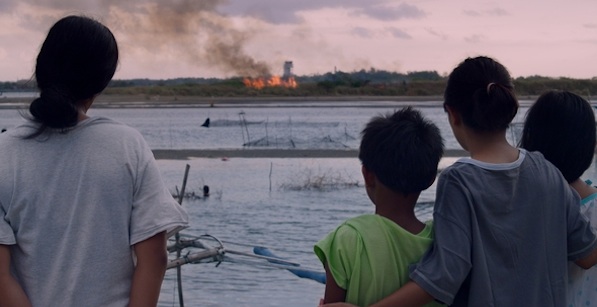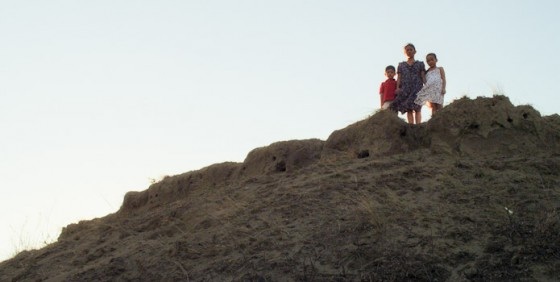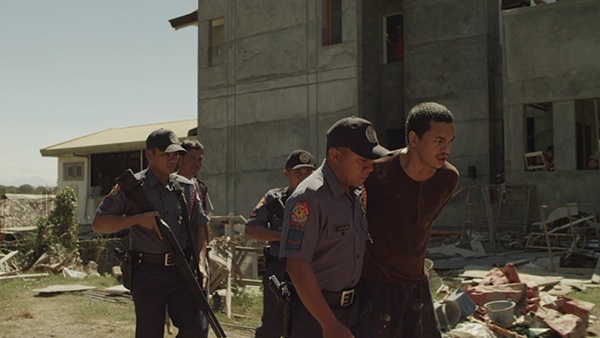Periodically, a master filmmaker known for making austere or otherwise forbidding work has an unexpected coalescence of critical and festival attention around a particular new effort. Relatively recent examples include I’m Going Home (Manoel de Oliveira, 2001), Va savoir! (Jacques Rivette, also 2001), and Razzle Dazzle: The Lost World (Ken Jacobs, 2007). Now, rather unexpectedly, the same has happened to indefatigable Filipino experimentalist Lav Diaz. His newest film, Norte, The End of History was his first to be featured at Cannes, is now in the main slate of the New York Film Festival, and was acquired for U.S. distribution (by Cinema Guild) earlier this week.
When this kind of “crossover appeal” happens, it raises certain questions, but we have to ask those questions intelligently and respectfully, lest we come off like rock-snob cretins, angry that the mundanes have discovered our favorite band. No, the issues are genuinely formal. Are the works that manage to reach outside the coterie actually more accessible (whatever that may mean)? Do external forces (festival politics, shifts in national fashion, etc.) help determine which filmmakers receive their “media moment?” Were cinephiles just admiring Diaz from a discrete distance, waiting for him to deliver a film under five hours long? Or, as many have claimed, does Norte represent a higher level of achievement, the masterpiece towards which Diaz has been steadily working for decades?
Not surprisingly, there is no one clear answer. Norte contains multitudes, which may well be why new viewers are finding entry points that were harder for them to locate in such earlier Diaz efforts as Death in the Land of Encantos (2007), Melancholia (2008), and Century of Birthing (2011). (And I myself must admit to having viewed these longer films in piecemeal fashion over a number of years. Norte is the first Diaz film I have watched in a single sitting.) There are certain obvious differences, particularly relating to form and grammar. Norte is Diaz’s first extensive use of color cinematography since Batang West Side in 2001. What’s more, while Diaz’s mature style has been characterized by general reliance on extended takes in a fixed-frame master shot style, Norte makes extensive use not only of medium shots and the occasional close-up, but a mobile, gliding camera.
So, if we accept that these attributes (color and camera movement) make films “more accessible,” then bingo. Norte is “Lav Diaz lite.” But this really isn’t true, largely because to simply note the use of these attributes is to fail to account for the uses to which Diaz puts them, to say nothing of the obvious pleasure he is taking in opening up this wider toolbox. Camera movements in Norte are typically slow tracking shots, pulling away from a scene in progress or inching laterally by as a quotidian event is unfolding, to place it in the context of its setting. In the former case, Diaz and cinematographer Larry Manda are rendering an action smaller and more obscure; in the latter, they deliver its specificity while implying that it may be metonymic for other, similar activities.
And this is to say nothing of Diaz’s use of color as a compositional device, the way that differential light is used to describe the ramshackle village where Eliza (Angeli Bayani) and her sister Ading (Hazel Orencio) scratch out a living, trying to raise Eliza’s kids Sarah and JR while their father Joaquin (Archie Alemania) is rotting away in prison. Likewise, the cramped apartment where law school dropout Fabian (Sid Lucero) hides from the world is streaked with deep purples and blues; when he repairs to his family farm to confront his sister Hoda (Miles Canapi), the sickly, sunlit pinks emphasize the illness of the space – that of Fabian, and the family line.
So, in light of these developments, it’s clear why some commentators are crying “masterpiece.” The very aspects of Norte that are helping it to connect with a broader audience are being utilized with great formal acumen, giving one the sense that Diaz withheld certain maneuvers until he felt he had some reason to deploy them. And in fact, one still observes a great many static shots and tableaux in the film, reminders of Diaz’s more painterly work in the previous black-and-white works.
Having said this, Norte strikes me as a film that, unlike Melancholia and Birthing in particular, begins to rely a bit too heavily on plot and incident, particularly after the first hour. As most reviews have already made clear, this film is a riff on Dostoyevsky, with plot and character elements from Crime and Punishment followed rather directly in the opening hour. Fabian is a pontificating post-Nietzschean jackass who eventually decides that he must commit murder in order to demonstrate total existential devotion to his nihilistic creed. (When we first meet him, he is declaring the 21st-century as a “post-truth” era, while trying to borrow money from two former professors.) So he goes to the home Miss Magda (Mae Paner), the local loan shark, and slays her, only to be surprised by her teenage daughter Criselle (Julia Domingo), who he unthinkingly kills as well.
From here, Diaz deviates from the Dostoyevsky and evokes Filipino nationalist José Rizal and certain key plot elements of his best-known novel, Noli Me Tángere. Joaquin, whose family was deeply in debt to Magda, assaulted her when she would not cooperate with him to lessen his burden. Days later she and her daughter were murdered, and although Joaquin was in another town working a construction job at the time, he is encouraged to plead guilty by an incompetent public defender. He receives life in prison. The remainder of Norte shifts back and forth between Joachin’s prison ordeals, Fabian’s increasing mental anguish, and Eliza’s struggle to care for the family, including an abortive attempt at child murder/suicide.
This is a political film. Fabian and Joaquin are clearly character foils in a literary sense, and Norte is about the two men (with Eliza in between) as possible fates for the nation of the Philippines. (The state of Ilocos Norte, where the film takes place, is where Ferdinand Marcos hailed from. When Fabian the scorched-earth philosopher implicitly proposes “the end of history,” it’s not coincidental that it would happen here.) Recent Diaz films have been equally political, but this one is neither tract nor lyric. It is novelistic, sometimes awkwardly so. Scenes after Joaquin is transferred to the Federal Penitentiary, for instance, at times seem to echo too many fish-in-the-joint movies, and before long you may think you’re witnessing the return of Andy Dufresne.
There are moments of stark beauty in the final three hours of Norte; Diaz never abandons his eye for poetic condensation, images that speak volumes in a few mere seconds. For instance, Eliza stands, looking over her sleeping children, not long after her daughter Sarah had to cope with bullies at school, teasing her about her father being a criminal. After several silent moments, the mother takes a 2×2 wooden stick and, as we see in an exterior reverse-shot, props open the kids’ bedroom window to let in the night air. As she does, a group of soldiers quietly goes jogging by on the street below. They have no purpose; they allude to the ever-present State, a constant concern for Diaz, but they don’t “mean” anything.
But it’s hard to compare moments such as this to the majority of Norte, which subordinates visual and sonic information to story efficiency. Critic Vadim Rizov called Norte “watchable,” there is no doubt about this. But considering that the first hour is so filled with surprising moments – the trip to the lake which turns into a lesson in Filipino revolutionary history, for example, or the slow, excruciating attention to Eliza’s removal of Joaquin’s leg cast—it’s hard not to feel as though Norte is also, in some respects, an experience of diminishing returns. Yes, “surprises” happen, including a last-minute character death, but they seem like attempts at wrapping up a sprawling epic that suddenly remembered its allegorical dimension. In the end, Fabian behaves like the amoral madmen he thought he only ironically admired. (In essence, he drops the philosophizing and morphs into Ferdinand Marcos.) And Joaquin, damaged leg, stabbed hand and all, remains behind bars, the literal Body Politic, wounded but still persevering. The final shot of Norte leaves us with Joaquin’s children, motherless but wandering on, out of frame and into an uncertain future.
Norte, The End of History is a good film. It is highly literate, and indeed, quite literary. But Diaz has for so long been one of our most painterly of filmmakers. I salute and admire the evolution of this Filipino filmmaker, even as I greet it with a touch of ambivalence.







